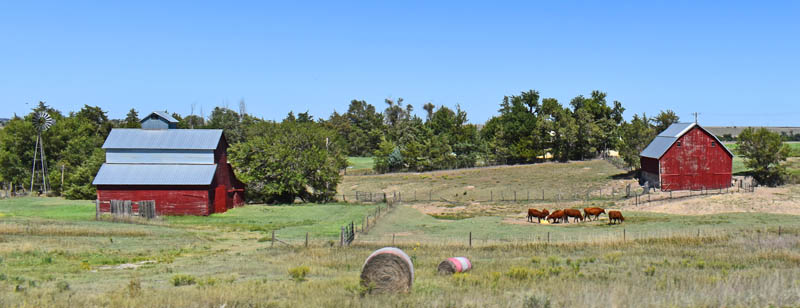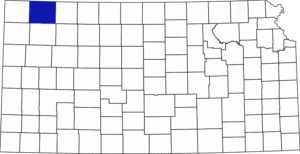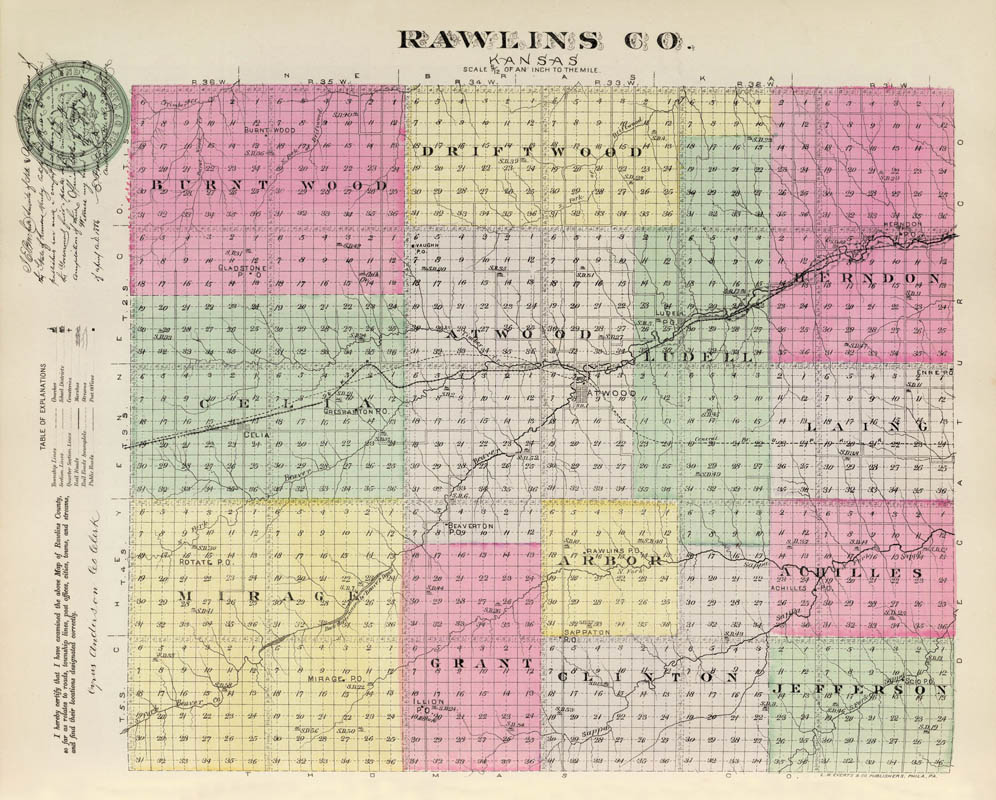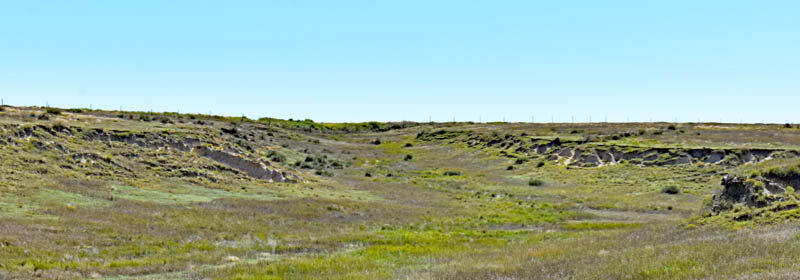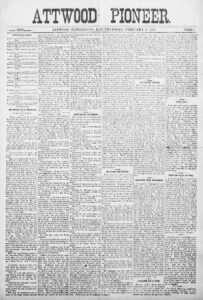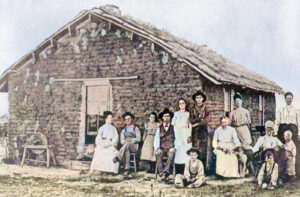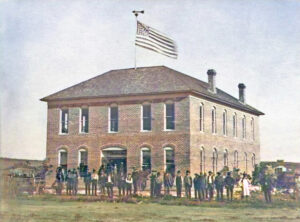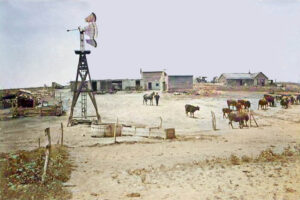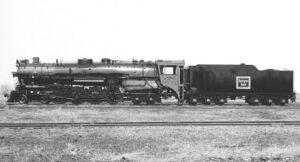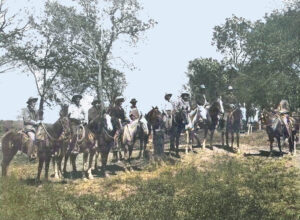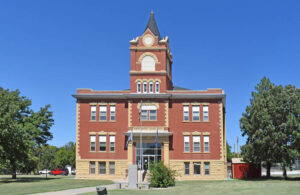Towns & Places:
Atwood (county seat)
Herndon
Ludell – Unincorporated and Extinct
McDonald
Battle of Sappa Creek (1875)
Cheyenne Raid (1878)
Rawlins County, Kansas, is located in the northwest part of the state. Its county seat and largest city is Atwood. As of the 2020 census, the county population was 2,561. It was named for General John A. Rawlins, an adjutant for Ulysses S. Grant during the Civil War, who later became the Secretary of War in the Grant administration.
The vast expanse of High Plains that today encompasses Rawlins County was once home and hunting ground to Cheyenne, Comanche, and Arapaho Indians. At that time, great herds of buffalo grazed on the vast prairies and along the streams.
Rawlins County, one of the northern tier, is the second county east of the Colorado line. It is bounded on the north by the State of Nebraska; on the east by Decatur County; on the south by Thomas County, and on the west by Cheyenne County. Rawlins County’s area is 1,080 square miles.
The general surface is an undulating prairie, with a few bluffs. Bottom lands averaged a mile in width. The streams were lined with thin belts of native timber.
Two branches of Beaver Creek enter the county in the southwest, flow northeast to the center, where they join to form one stream, which then continues northeast into Decatur County. The north and south forks of Sappa Creek flow across the southeastern part; Timber and Burntwood Creeks are in the northwest, and Driftwood in the northeast. Limestone, coal, and sandstone are found in limited quantities. Springs were frequent in the valleys.
Prairie land comprised about 96% of the territory, while timber land accounted for 4%. The soil was a rich, black loam; springs of living water are numerous; excellent clay for making bricks exists; white and yellow magnesium limestone is abundant, and what is called native lime is found in large banks.
The county is watered by the South and North Forks of Sappa Creek, which rise in Sherman County, and by the Beaver, Little Beaver, and North Beaver Creeks, the first two of which also rise in Sherman County. Beaver Creek waters the southwest and central portions of the county. The varieties of timber are ash, box elder, cottonwood, elm, walnut, and willow.
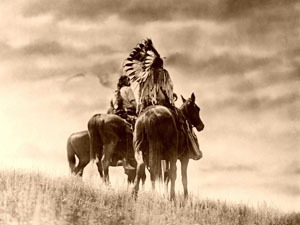
Cheyenne Warriors by Edward S. Curtis, 1905.
Although hostilities between whites and Native Americans occurred throughout the West before the end of the Civil War, the Plains Indian Wars became a significant concern to Kansans after 1865. Various Plains tribes associated with Kansas, such as the Cheyenne and Kiowa, clashed with white settlers who encroached upon their traditional hunting grounds during the years following the war. Several individual skirmishes and two sizable battles occurred in northwest Kansas, within the boundaries of what is now Rawlins County.
As early as 1872, there were Indian traders and campaigns of buffalo hunters in the area, licensed by the government. These hunters would hunt the buffalo by the thousands for their hides, and sometimes they would cut off the hindquarters and dry them. It was not long until the prairies were covered with the bleached bones of the buffalo. The Pawnee, Cheyenne, and Sioux were the tribes that lived in Rawlins County at this time.
Thirteen government surveyors were killed between the forks of the Beaver and Herndon Creeks in June 1872 by Whistler’s band of Sioux Indians.
The 1873 Legislature created Rawlins County; however, it wasn’t organized for several years.

Sappa Creek Massacre Site in Rawlins County, Kansas. Courtesy of Kansas Historic Resources Inventory.
Before the first homesteaders arrived in 1875, near what is now the town of Ludell, the open prairie was visited only by wild animals, indians, buffalo hunters, and longhorns driven along the Texas Trail to Ogallala, Nebraska. The Battle of Sappa Creek, which occurred in April 1875, was about the time the first white settlers came to the county. Early in the year, a band of Northern Cheyenne Indians, including 75 men, women, and children, was on its way from the Indian Territory (Oklahoma) to its home in the Black Hills of South Dakota and was in orderly march about 40 miles west of the settlements when on April 18, Lieutenant Austin Henley, of the United States Cavalry, received orders to intercept the band and turn it back. The cavalry followed the Indians for several days, during which time the Cheyenne tried to escape by dividing up into small groups. However, they were overtaken while in camp on Sappa Creek, and almost the entire camp, including women and children, was murdered. In burning their tepees after the slaughter, an Indian baby was accidentally thrown into the fire and perished. One young Indian who had no family escaped.
August C. Blume of Ludell was the first man to take out homestead papers and make a settlement in Rawlins County. In May 1875, Mr. Blume, August Deitleff, Albert E. Lange, Charles Nast, and Antone Stermer, Germans, made the first settlement in the county. Coming up Beaver Creek from Crete, Nebraska, they traveled as far as Cedar Bluff in Decatur County, where they met a Mr. Dimmick, who located them just west of Ludell. When they came, they saw a roving band of Cheyenne Indians. A.C. Blume stayed with his homestead for several years and became one of the substantial men of the county.
Immigrants to Rawlins County came from Ireland, England, the Scandinavian countries, and the Middle European countries. However, each group of immigrants did not associate with the others. The Swedes settled the area surrounding the Enne Post Office; the English settled in Grant Township in the south-central part of the county in a little community they called Ilion; the Hungarians/Austrians settled in Herndon; and the Germans settled in Ludell. The Irish and Danish settled in south-central Rawlins County, and the Czechs settled north and west of Atwood.
In the fall of 1876, the first large herd of cattle came to this county from Texas. At that time, Charlie Webber brought about 800 head of cattle and located just north of Atwood on what later became the B.D. Hotchkiss Ranch.
In the spring of 1877, Jeff McCoy and Sim Holstein established a ranch, and Mr. Holstein erected a frame house. The building was framed in Kansas City and shipped to Grinnell on the Union Pacific Railroad, some 65 miles from Atwood, and from there was hauled overland. John Bande, from Bohemia, came to the county in the spring of 1877, and his boy, Karl, is the first child born in the county.
On September 8, 1878, a report was made to Governor George Anthony that a band of 300 Northern Cheyenne led by Chiefs Dull Knife and Little Wolf had left their reservation near Fort Reno, Oklahoma, and fled for their homeland in the north. The Indians did but minor damage until they reached Sheridan, Decatur, and Rawlins Counties. Known as the Cheyenne Raid, it was the last Indian battle in Kansas.
On Sappa Creek in Decatur County, 17 were killed outright or died of wounds inflicted by the Indians. After committing these crimes, the Indians passed northward on October 1 and killed 13 settlers on Beaver Creek between Traer and Ludell. After the raid, they killed many cattle in the canyon to the south, which is now known as Hundred Head Draw. Mr. Stermer was shot in his cornfield, within a few steps of his wife, Dena Stermer. Mrs. S. then improved their claim. Mrs. Bella, wife of August C. Blume was on their claim during a raid made by the Cheyenne, and was often months alone prior to the raid, while her husband was working for food for his family. Mr. Lange was the brother of Mrs. Stermer, whose husband was killed by the Indians. As they fled north, the Cheyenne left behind a wounded indian boy, who was later killed by white settlers.
Trouble arose between Mr. Webber and some of the settlers over the missing cattle, and the cattle king became afraid and sold out to Jeff McCoy. At that time, McCoy and Holstein had some 1,500 head of cattle. C.C. Pearson and Pat McCluskey of Cheyenne County were two cowboys who came from Texas with the McCoy cattle. In 1879 and 1880, settlers arrived in large numbers.
The far-seeing cattlemen were convinced that the days of successful free range were about ended. One of the first to leave was Jeff McCoy. A farewell ball was given in honor of his departure. It was the first of those entertainments which, for years afterward, formed the leading feature of our social life. Cowboys, grangers, saints, and sinners attended this ball.
Immigrants to Rawlins County came from Ireland, England, the Scandinavian countries, and the Middle European countries. However, each group of immigrants did not associate with the others. The Swedes settled the area surrounding the Enne Post Office; the English settled in Grant Township in the south-central part of the county in a little community they called Ilion; the Hungarians/Austrians settled in Herndon; and the Germans settled in Ludell. The Irish and Danish settled in south-central Rawlins County, and the Czechs settled north and west of Atwood.
The first newspaper in the county was the Atwood Pioneer, established in October 1879, by Edwin and A.L. Thorne. That year, the newspaper reported that there was only one school district for the entire county, District Number 1, located in Atwood. In his salutatory, Mr. Thorne said:
“Four months ago, we directed the Review, then being published in Millerstown, in Butler County, Pennsylvania, to be closed with a view to the removal of the office, presses, and type to the new and flourishing State of Kansas. We landed at Atchison in November 1857 and lived in Brown County until the fall of 1860. After this long absence, our search for a home on public and unoccupied land brought us to Rawlins County, at Atwood, at the forks of Beaver Creek, as the most desirable and promising location.”
Reverend A.S. Thorne was the Presbyterian Missionary for Rawlins, Thomas, and adjoining counties. In their religious directory, it is announced that Mr. Thorne would preach every Sabbath morning in the post office building. Reverend J. Langley, M.E., alternate Sabbaths at 3 p.m. A Sunday school had been organized on October 19, with Reverend A.S. Thorne, Superintendent; W.H. Hopkins, Assistant Superintendent; J.C. Christian, Secretary and Treasurer; A. Vinton, Librarian; Reverend Mr. Thorne, who was also the agent for the American Bible Society, donated ten Bibles and 20 Testaments.
In the early part of 1880, an effort was made to form a township, but the commissioners of Norton County objected for the reason that that county would bear all the expenses and no tax could be collected to reimburse them.
As bones brought from $6 to $9 per ton, the settlers gathered them and hauled them either to the Kansas Pacific Railroad at Grinnell or Grainfield, some distant, or to the Burlington Indianola, nearly 60 miles away. It was reported that these bone haulers, in order to make their business more remunerative, would take these bones and soak them overnight in the Saline or Republican Rivers. If they wanted to get even with the scales, they would fill the skulls, hollow bones, and horns with wet sand.
In February 1880, the first issue of the Atwood Pioneer was made with A.S. Thorne as editor. He was a Presbyterian preacher of more than ordinary ability. He had four sons who were all useful in the printing office.
On June 1, 1880, C.S. Winslow became the manager of the Pioneer Publishing Company, and in his salutatory, said:
“The Pioneer shall ever be opposed to monopolies; to repudiation; to depreciated or bogus currency; and to the use of alcoholic liquors as a beverage.”
In August, Mr. Winslow was succeeded by Reverend A.S. Thorne, who proposed to make the Pioneer “a medium of good to the entire people of the county, knowing no party, locality or faction who shall control its columns to the detriment of any.” Following the issue of December 11 of the same year, the publication of the paper was suspended.
The first issue of the Citizen was on September 10, 1880, with J.D. Greason as its editor.
Immediately before the November election, the sheriff of Norton County issued his proclamation to the electors of Rawlins Township, providing for an election at which they would vote for the President. Electors, Congressman, Governor, and other full state complement officers, of State township officers, including justices of the peace and two constables.
In November 1880, an election was held as a municipal township of the county, at which time the county polled 182 votes. Its population at that time was 1,623.
The year 1880 was a dry one, and the Texas cattle destroyed the few crops raised.
In 1880, the population of the county was 1,623; males, 21 years of age and over, to the manor born 428; of foreign birth, 116.
Between 1880 and 1881, the area was settled by a significant number of people. In February 1881, there was another township election, at which time Rawlins County polled about 100 votes.
Early in 1881, efforts were made to organize the county. The people of Atwood urged organization because they wanted the land office for the new land district located at Atwood, as the Department of the Interior was understood to be averse to the location of the office in an unorganized county. Following the assessment of Pauline Township, Decatur County was organized and claimed the taxes. To avoid paying these taxes to Decatur County, Rawlins County was subsequently organized.
The cattlemen were opposed to the idea of organization, as it was understood that they would bear the burdens of taxation and reap few or no political or other advantages. Upon a memorial being presented to Governor John P. St.John, signed by 26 householders, residents of Rawlins Township, showing that the township had 1,500 actual settlers and praying for organization, the Governor proclaimed organization. He appointed Lorenz Demminer and August C. Blume and Herman Kase were county commissioners, and William R. Shuley was appointed county clerk. Atwood was designated and declared to be the temporary county seat.
Rawlins Township was organized as Rawlins County on May 25, 1881, and Governor John Pierce St. John, in his proclamation, made Atwood the temporary county seat.
In July 1881, county citizens voted on the county seat, with 314 votes cast. The voters were electing whether Blakeman or Atwood would become the permanent county seat. Atwood was chosen, and the following officers were chosen: County Clerk, William Reilly; commissioners, Albert Hemming, August C. Blume and Herman Kase; treasurer, Greenup Leaper; register of deeds, John F. Hayes; sheriff, Edward H. James; coroner, Leonard Wiltse; superintendent of public instruction, W.W. Dennis; probate judge, R.W. Fowler; attorney, Patrick Fleming; clerk of the district court, A. Birdsall. At the November election, O.L. Palmer was elected representative.
The first building used as a courthouse was owned by C.S. Starback and was located just west of A.A. Smith’s hardware store on the corner of Third and Main Streets. Mr. Starback erected the building for a jewelry store in 1880.
The county was divided into 20 townships, including Achilles, Arbor, Atwood, Beaver, Burntwood, Celia, Clinton, Driftwood, Elk, Grant, Herndon, Jefferson, Laing, Logan, Ludell, Mikesell, Mirage, Richland, Rotate, and Union.
In 1881, the number of people of school age in the county was 455, and school enrollment was 94. The preponderance of males over females was 75. There were five schoolhouses in the county; the total amount received in 1881 for school purposes was $204.60.
The Republican Citizen, a five-column newspaper, was first published in January 1882 by J.M. Matheny and J.D. Greason as editors and publishers. On January 27, Cyrus Anderson succeeded Mr. Matheny. On June 9, Mr. Greason was the sole editor and publisher, and so remained until January 1, 1883. It entered upon its third volume on December 14, 1882.
On January 7, 1882, No. 1 of Volume I of the Rawlins County Pioneer newspaper appeared, with A.S. Thorne and Edwin P. Thorne, publishers and proprietors. They proposed to be in politics, Republican, but in no partisan sense. On April 19, Mrs. E.P. Thorne appears as editor, and on May 3, A.S. Thorne, publisher. The August numbers of the Pioneer were half sheets, patent outside–the last one being No. 27, Volume II, August 23. Volume II was assumed on January 14; it became the Toiler’s Organ, and on January 28, it announced itself as the continuation of the Atwood Pioneer.
In 1882, the number of people of school age in the county was 510, and school enrollment was 192, with an average attendance of 123. The preponderance of males over females in 1882 was 24. At that time, there were nine organized school districts and five schoolhouses in the county. That year, the average monthly pay for male teachers was $20, while that for female teachers was $14.83.
Reports from the county to the State Board of Agriculture are reported for the year 1882. The acreage of winter wheat was 866. John Gleason, Atwood, had 10 acres, yielding 37 bushels per acre; Paul Demmer, Herndon, had 20 acres, 35 bushels per acre; James K. Bliss had wheat averaging 68 pounds to the bushel. There were 180 acres of spring wheat, 4,381 acres of corn, 591 acres of rye, 58 acres of oats, 8 acres of barley, 33 acres of Irish potatoes, 102 acres of sorghum, 43 acres of castor beans, 31 acres of broom corn, 1,029 acres of millet, and Hungarian. It produced 800 pounds of cheese, 18,807 pounds of butter, and the value of animals sold for slaughter $688. The valuation of property for 1882 was $49,378.73, which was personal property. There were 481 horses, 78 mules, 266 swine, 976 sheep, and 1,646 cattle.
A branch of the Chicago, Burlington & Quincy Railroad from Nebraska entered near the northeast corner. It crosses southwest a distance of nearly 40 miles into Cheyenne County, terminating at St. Francis.
In 1887, the legislature authorized the county commissioners to levy a tax to build a courthouse, such tax not to exceed the sum of $20,000.
In order to retain the county seat at Atwood during the effort of the Burlington and Missouri Railroad to move it to Blakeman, it was necessary to have a courthouse. In the fall election of 1887, the proposition to vote on bonds to build a courthouse was lost by 144 votes. The Atwood people were not discouraged by this defeat. The city of Atwood voted on bonds for $3,500 to build a city hall, which was located on two lots donated by S.F. Lloyd. These lots were well set with trees, which were higher than the courthouse. This two-story city hall was later donated to the county for use as a courthouse. The county commissioners purchased two steel jail cells for $4,000, and the jail was contracted to be built for $450.
In 1890, the county’s population was 6,756. During the next decade, it lost population, as did all the western counties.
In 1900, the county’s population was 5,214.
The cattle interests of the county were never greater than they were in the early 1900s. Nearly every farmer has a few cattle. Many more had from 25 to 100 heads. Ex-President Perkins, of the Burlington and Missouri Railroad, owned over a township in this county, upon which grazed over 500 head of cattle.
In 1902, C.P. Dewey, of Chicago, Illinois, had one of the largest cattle ranches in the state, located in the southwest corner of this county, and reaching out into Cheyenne, Thomas, and Sherman Counties. Frank Rockefeller, of Cleveland, Ohio, also operated a large cattle ranch in this county. The assessors’ returns show that on March 1, there were 23,225 head of cattle in Rawlins County.
On December 15, 1905, the Rawlins County Courthouse burned down.
The second and present courthouse was designed by Eisenfraut-Colby-Pottinger Company and was constructed from 1906 to 1907 by Winters & Short. The three-story, dark red colored brick, stone, and concrete structure is located on spacious, landscaped grounds in the center of Atwood. The building features a central square, a red-colored brick tower with a steep roof rising above the south entrance. The south front has steps up to a stone-trimmed entrance with glass paneling. The roof is hipped with gable ends on three sides. In the interior, the County District Court courtroom is located on the north side of the third story. The building houses the County District Court of the 15th Judicial District. The Romanesque Revival building is located at 607 Main Street in Atwood.
In 1910, there were 89 organized school districts and 2,069 school-age inhabitants. At that time, the county’s population was 6,380, and the assessed valuation of property was $8,827,603. The total value of farm products in 1910 was $1,531,974. That year, the assessed valuation of property was $8,827,603.
The first county fair was held in McDonald in September 1918, and later moved to Atwood.
Rawlins County’s population peaked at 7,362 in 1930. In the following decades, the population gradually dropped, and several small towns became extinct.
Today, the county is served by the Rawlins County Unified School District 105, headquartered in Atwood.
The Rawlins County Museum in Atwood, Kansas, is the Headquarters for the Rawlins County Historical Society. The museum depicts rural Kansas history. There are recreations of a beauty parlor, post office, doctor’s office, dentist’s office, and a schoolroom. Other displays feature items from the life of former Kansas Governor and Atwood native Mike Hayden, as well as clocks, cameras, tools, and Hopi kachina dolls.
Lake Atwood, located just north of Atwood on U.S. Highway 36, provides recreation, camping, hiking, and fishing.
©Kathy Alexander/Legends of Kansas, updated September 2025.
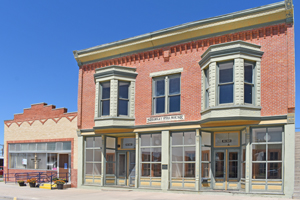
Post Office and Opera House in Atwood, Kansas. The two-story red brick Shirley Opera House, at right, was constructed in 1907. The Late Victorian-era commercial building was listed on the National Register of Historic Places on January 16, 2007. Photo by Kathy Alexander.
Also See:
Sources:
American Archive
American Courthouses
Blackmar, Frank W.; Kansas: A Cyclopedia of State History, Vol I; Standard Publishing
Fort Hays State University
Historical Marker Database
Kansas Post Office History
Rawlins County, Kansas
Topeka Daily Capitol, October 19, 1902
Wikipedia

